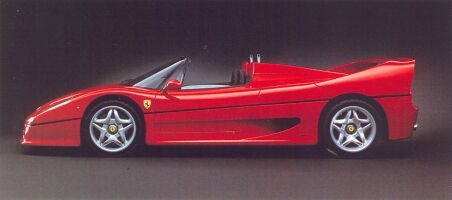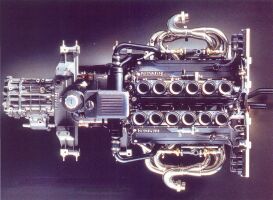The engine was developed from the 1990
3.5-litre F1 unit and retains its length, five valves per cylinder and
65deg vee angle. The capacity was increased to 4698cc, catalytic converters
were fitted and both the inlet manifold and exhaust feature variable geometry
systems. Dry-sump lubrication (complete with three scavenge pumps), forged
titanium conrods and various magnesium castings complete the powerplant.
The body retains the F1 concept of a carbon-fibre
central tub - from the front bulkhead to the hollow rear one (which contains
the fuel cell). To the front bulkhead is bolted the front suspension and
steering rack, to the rear the engine. The body panels are all unstressed
and also made from carbon-fibre. Steel is used for the roll-bars, door-bars
and the frame supporting the radiator.
As usual, the job of designing the F50
was given to Pininfarina. Initially intended to be available in both coupe
and barchetta versions, these were later merged into one design, convertible
by the owner. The drag coefficient of 0.372 is high, but results from the
high levels of downforce required. At its top speed the F50 generates over
400kg of downforce, helped by the flat bottom with rear diffusers, the
rear wing, and the upward exiting radiators a the front.
A total of 349 examples were produced. The
F50 was built with the aim of making a road car which was as similar to
a Formula One car as possible. The two main technologies being a naturally
aspirated V12 at the rear and a carbon-fibre chassis with a stressed engine.
The F50 has both of these.
The
F50 was built with the aim of making a road car which was as similar to
a Formula One car as possible. The two main technologies being a naturally
aspirated V12 at the rear and a carbon-fibre chassis with a stressed engine.
The F50 has both of these.
 The
rear suspension bolts to the magnesium gearbox housing, and like the front
suspension, uses horizontally mounted coil/damper units activated by pushrods.
All the dampers are electronically adjustable, controlled from an electronic
module which measures numerous parameters (steering wheel angle & velocity,
vertical & longitudinal acceleration, brake pressure and vehicle speed).
All suspension joints use rose-joints/uniballs.
The
rear suspension bolts to the magnesium gearbox housing, and like the front
suspension, uses horizontally mounted coil/damper units activated by pushrods.
All the dampers are electronically adjustable, controlled from an electronic
module which measures numerous parameters (steering wheel angle & velocity,
vertical & longitudinal acceleration, brake pressure and vehicle speed).
All suspension joints use rose-joints/uniballs.
Technical Details
| Engine | 4698cc (85x69mm) 60 valve quad-cam 65deg V12 with 513bhp @ 8,000rpm
aluminium cylinder head, cast-iron cylinder block compression ratio : 11.3:1 |
| Suspension | front : double wishbones with pushrod activated (horizontally mounted) coil spring/damper units with adaptive
damping plus anti-roll bar
rear : double wishbones with pushrod activated (horizontally mounted) coil spring/damper units with adaptive damping plus anti-roll bar wheels (front/rear) : 8.5x18in/13x18in tyres (front/rear) : 245/35-ZR18/335/30-ZR18 Goodyear GS-Fiorano wheelbase : 2580mm track (front/rear) : 1620mm/1602mm |
| Brakes | ventilated discs (diameters : front 355mm; rear 335mm)
Brembo four pot callipers, Pagid pads |
| Transmission | 6 speed manual
hydraulically actuated, twin-plate (dry) clutch transmission oil to water (engine coolant) heat exchanger |
| Steering | rack and pinion, unassisted, 3.3 turns lock-to-lock |
| Empty weight | 1230kg (42% front / 58% rear)
Engine (dry) weight : 198kg |
See our picture gallery index for images from museums, motorshows and events.
There are also wallpapers/desktop backgrounds available to download.
Use the buttons at the top to navigate
further, or
Copyright © 2000 to 2011 CarsfromItaly